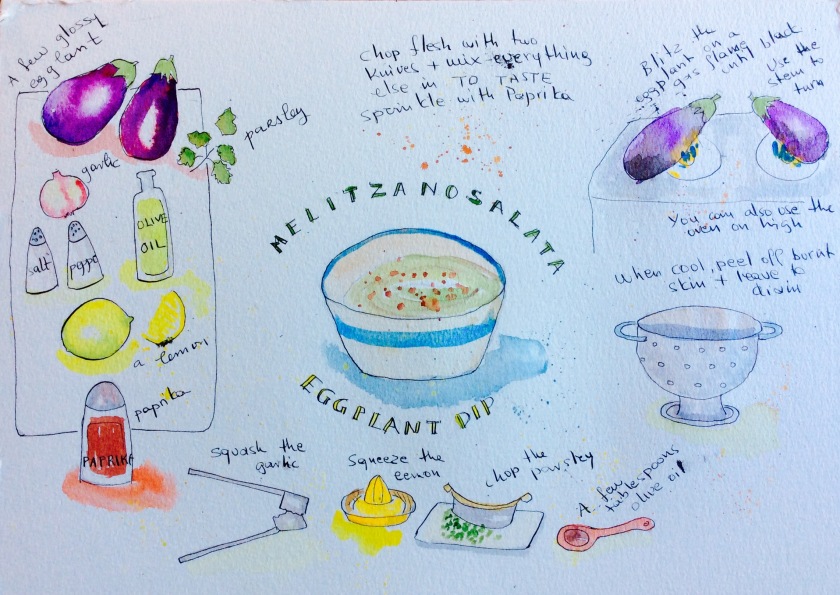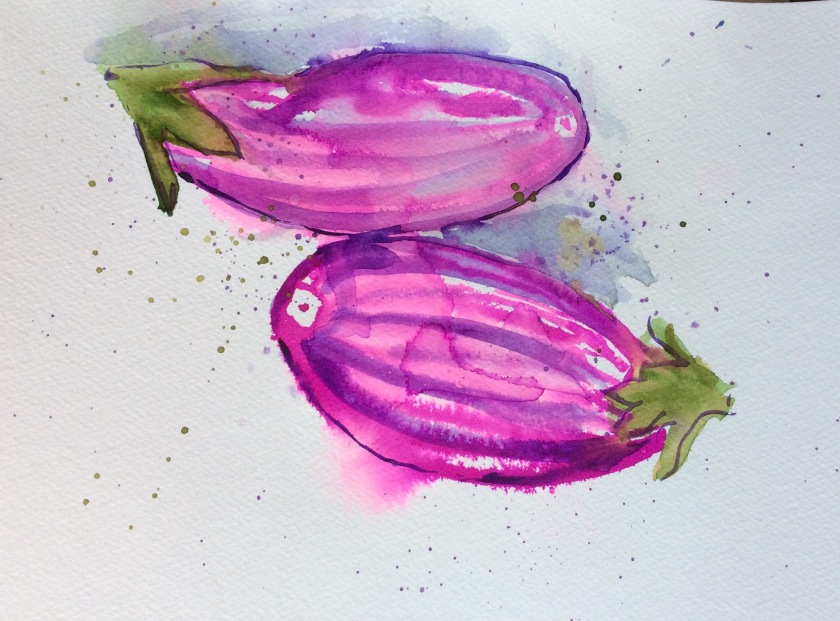The English call it aubergine, the Americans eggplant. We call it melitzana. Well, apparently this glossy purple vegetable has now outpaced kale, avocado and broccoli to become the new ‘must’ in healthy eating.
Aubergines have always been a favorite in Greek cuisine. Fried crispy and sprinkled with salt, they make a delicious (if not super-healthy) starter in tavernas.
Braised with tomatoe and onions they become imam bayildi, a recipe we share with all our neighbors in the eastern Mediterranean: the name in Turkish means ‘the Imam fainted‘ – presumably due to the deliciousness of the dish, or, in another version, because he was horrified at the amount of oil used to cook it. An old folktale relates that an imam married the daughter of an olive oil merchant, whose dowry consisted of twelve jars of the finest olive oil. Each evening for twelve days, she prepared for him a succulent eggplant dish with tomatoes and onions; but on the thirteenth day, no dish appeared at the table. When informed that there was no more olive oil, the imam fainted.

Puréed and paired with stewed beef or lamb aubergines make the ultimate comfort food, Hünkar Beğendi, an inheritance from the Ottoman cuisine. There are two different stories surrounding the name of this dish, which literately translates as “the Sultan liked it.” The first one is that the dish was created for Sultan Murad IV (1612-1640) – either in the palace kitchens or in the kitchen of a house where Murad IV spent a night on his way back from a hunting trip – and he adored it. The second rumor is that the same dish was served to Empress Eugenie, the wife of Napoleon III, in Sultan Abdülaziz’s Beylerbeyi Palace in 1869, and she liked it so much that Abdülaziz promised to ask his chef to give Eugenie’s cook the recipe, something he was reluctant to do!
Layered with other vegetables, and topped with béchamel sauce, aubergines make up the ubiquitous moussaka. Another version is the very popular Italian melanzane alla parmigiana.
All the above recipes, though delicious, are hardly the stuff of a ‘healthy’ diet. For simpler dishes, try melitzanosalata (eggplant dip), a Levantine dish known in the Middle East, where they add tahini, as baba ganoush. The Arabic term means “pampered papa” or “coy daddy”, perhaps with reference to a member of a royal harem.
Aubergines soaked in ice water (otherwise they absorb too much oil) and gently braised in a covered frying pan with a clove of garlic, then sprinkled with basil leaves, make the ideal vegetarian lunch or an accompaniment for meat or chicken.

So, how healthy are they?
Purple fruit and veg in general – think beetroot, blueberries, plums, red cabbage – are beneficial because the anthocyanin that provides their colour is a powerful antioxidant. Aubergine skin is also high in phytonutrients and chlorogenic acid.
Aubergines are an excellent source of dietary fibre, of vitamins B1 and B6 and potassium. In addition they’re high in the minerals copper, magnesium and manganese.
Aubergines are a member of the nightshade family; centuries ago, the common eggplant was referred to as “mad apple” due to belief that eating it regularly would cause mental illness. The vegetable produces glycoalkaloids, bitter compounds which are there to defend plants against bacteria, fungi, viruses, and insects. Glycoalkaloids are found throughout the plant, but their concentrations are especially high in leaves, flowers, and unripe fruits. They are known to overstimulate the nervous system, and have had deleterious effects in laboratory animals, however they are found in aubergines only in negligible amounts. So they are pretty safe to eat.
As to their relative merits, I think all vegetables are good for the health as well as delicious, so it boils down to a matter of taste.



Such a shame, but I simply cannot stand Aubergines. Something about the texture really puts me off. We have a friend married to a Turkish lady, and she once prepared us a similar ‘Sultan’s Dish’ when we visited. As I knew that she had spent so long preparing it in our honour, I ate as much as I could, before declaring myself ‘too full to eat anymore’. I hope that I am never offered it again, healthy or not.
Best wishes, Pete.
LikeLike
Oh dear… But there’s no accounting for taste – and thankfully, no obligation to eat aubergines! I used to hate them as a child – now I love them.
LikeLike
What a wonderful post! My husband doesn’t care for them much, but occasionally I serve lasagne made with thin char grilled slices of aubergine instead of the pasta sheets, a more coeliac-friendly version. They’re also wonderful grilled with a thin slice of swiss cheese melted on top 🙂
LikeLiked by 1 person
Or crumbled feta!
LikeLike
I like the Swiss for the sweet nuttiness of the flavour and its contrast with the aubergine, but feta would indeed be lovely too.
LikeLiked by 1 person
Unlike Pete, I adore Aubergines!
LikeLiked by 1 person
Aubergine is so much prettier of a word than eggplant. Growing up in a family that was deeply suspicious of them, I was afraid to try them. When I finally did, I had over-complicated recipes that involved salt and soaking and paper towels, etc. which further convinced me they must be toxic on some way. Finally at this summer’s farmer’s market, at my favorite hippie organic stand, the dread-locked young man told me just to sauté it up. So I did, with very little olive oil, some onion and garlic. I threw in some broasted chicken and a small amount of tomato sauce~heaven! Now I am a fan 🙂
LikeLike
I think old-fashioned varieties needed soaking etc because they were much more bitter. Now most are sweet and don’t need it.
LikeLike
Ah, that explains it. I was totally afraid I was somehow about to poison my family but we all survived 🙂
LikeLiked by 1 person
I loved your aubergine post! We had melitzanosalata as part of a meze lunch today! A few years ago we were in the little harbour of Leonidion Plaka, on the eastern Peloponese, and there was an aubergine festival that night, it was excellent. The area specialised in the attractive striped aubergines which you mentioned.
LikeLiked by 1 person
Thanks, Georgie, glad you enjoyed it.
LikeLike
I love them in Italian and Greek cuisine, but haven’t made a dish with them successfully myself.
Your paintings are of them are great!
LikeLike
Thanks!
LikeLiked by 1 person
You can also do a nice sauce for pasta with chopped onion, garlic, mushrooms, aubergines, courgettes, even stick in a few chopped carrots, then add tomato sauce and simmer. Pour over pennes. Add parmesan cheese. Complement with rocket/cucumber salad…
LikeLiked by 1 person
Good idea!
LikeLiked by 1 person
An interesting journey through the aubergine! Not one of my favourites I’m afraid, though I do like some aubergine dishes.
LikeLiked by 1 person
I don’t go out of my way for them, I have to admit, mainly because they soak up so much oil that I’ve never quite sure what they taste of.
The paintings are lovely, especially the first one of the plain purple aubergines. If nothing else, they’re lovely vegetables to look at.
LikeLiked by 1 person
Thank you! Putting them in a bowl of iced water for a few minutes stops them soaking up so much oil. Then you can cook them gently in a covered frying pan with just a little oil, cut in chunks. Stir them once or twice, flavor with garlic and basil and salt and pepper. It takes 10-15′ and they are delicious!
LikeLiked by 1 person
Thank you for the tip.
LikeLiked by 1 person
Sliced? I never heard of this. It sounds like a great idea.
LikeLiked by 1 person
Cut in chunks
LikeLiked by 1 person
I absolutely adore aubergines, so much so that I grow my own. We eat them only when they are in season, but then we eat a substantial amount! Mostly stuffed with all sorts of things like lentils or blue cheese and walnuts…
LikeLike
Ooh, must try that!💕
LikeLike
I love aubergines and I love moussaka. My husband used to hate them before our marriage. Now he is a big fan of anything with aubergines in it.
LikeLiked by 1 person
It is an acquired taste, and the recipe matters too
LikeLiked by 1 person
We had it only once when I was a kid, and of course we knew it as “eggplant”. None of us cared for it very much, but Dad confided that was because, “Your mother doesn’t know how to cook it.” lol I’ve had it since and enjoyed it. 🙂
LikeLiked by 1 person
Loved the story! But eggplant is not very kid-friendly, I think. More of a grown up taste. I used to hate it as a child.
LikeLiked by 1 person
Living in a New World country like Australia we naturally use both versions, tho’ most settle on the ‘humble’ eggplant. And I have had the imam faint in my kitchen too many times to pay much attention any more 🙂 ! Love eggplant – buy it even out of season and just adore holding that beautiful, sleek, smooth, sexy vegetable in my hands! Am absolutely impossible at posting ‘directions’ but the wonderful Chicago food blogger John Amici has just thrilled many of us with his aubergine recipes on his blog ‘Bartolini Kitchens’ – why not ask Mr Google . . . : ??
LikeLiked by 1 person
Thank you – I will definitely look him up ASAP.
LikeLike
I found the Bartolini blog, which by chance I opened on a post entitled ‘The incredible edible eggplant’! I have now followed. X
LikeLike
dearHeart- exactly why I sent this 🙂 !! John’s present family ‘tree’ is mostly located in San Marino . . . so, not so far from you 🙂 !
LikeLiked by 1 person
🌺
LikeLike
A most interesting and informative post. Marina. I do enjoy aubergines, but hubby isn’t keen. Sometimes I manage to disguise them in a tasty sauce, and he doesn’t really know what he’s eating. 🙂 i love your paintings.
LikeLike
Thanks! Try him with the dip, it might change his mind… Plenty of recipes to be had on line.
LikeLiked by 1 person
Oh no. I love kale, avocado and broccoli. 😉 Good thing I like this, too. That dip sounds delicious. I didn’t know about the nightshade. Interesting. And…those are your watercolor paintings? They are gorgeous.
LikeLike
Yes, they are, thank you🌹You should try making the dip – I do it by taste, but there are plenty of recipes on line to get you started!
LikeLike
Fascinating. I’ve never like the oiliness of aubergines, but your ice water seems worth pursuing. Nice paintings
LikeLiked by 1 person
Jackie should have a go. And the dip is not oily at all.
LikeLiked by 1 person
They are used in Middle eastern cooking so much! Yumm
LikeLiked by 1 person
I like how those dish names are based on royal reactions to them. I’d love a few in English called something like, “the king loved it” or “the emperor thought it was pretty tasty.” I don’t know a lot about Ottoman cuisine or the dishes you mentioned, but I do like eggplant, so I’m pretty sure I’d enjoy them. 🙂
LikeLike
Very chic, aren’t they? You would love them, and the dip is very easy to make.
LikeLiked by 1 person
Sounds great! 😀
LikeLiked by 1 person
Great post, I should pop by more often.
We have just discovered a preserve called Lutencia, which we make with roasted peppers, aubergines, a chilli and various other things that I didn’t spot going into the blender. Very tasty, lifted by the texture which I’m sure comes from the aubergine.
LikeLiked by 1 person
So many blogs, so little time… I must pop by yours more,often, too😊
LikeLike
Ooh, I love baba ghanoush, and not just because eggplants are now trendy super food. Really great watercolor paintings!!!!! You’re very talented!!
LikeLiked by 1 person
Thanks! Not enough, to my liking – self-taught, so lacking technique. But I enjoy it.
LikeLiked by 1 person
I am going to save this posting and try some (or all!) Normally I think of eating eggplant is like chewing my way through bits of cardboard!
LikeLiked by 1 person
Go on, be brave!
LikeLiked by 1 person
I really enjoyed this post Marina. Egg plant is a favourite, especially fried. It does bother me how much oil they absorb so I’ll try the ice water trick.
I just love your watercolours!
LikeLike
Thank you Robyn!🌹
LikeLike
The Japanese love eggplant! My mom made it often but the rest of the family did not have the same affection for them. Your post has inspired me to try them again. Maybe a dip to start. 🙂
LikeLiked by 1 person
Yes, try it!
LikeLike
Just wish I could grow them. Lots flowers – no set fruit this year inthe poly tunnel. Luscious colours!
LikeLike
Plants have to find their spot to thrive! 😕
LikeLike
Just in time! I bought an aubergine and was wondering what to cook from it. I am usually cooking a stew from aubergines, courgettes, onion, bell paper, tomatoes and carrots.
LikeLike
Nightshade family..excellent!
Loved the drawings and the combo of useful information with your usual wit!
LikeLike
Thank you, Peter!☀️
LikeLike
WOW! i deeply in love with your drawing! the color is fresh and deep and it’s like you aren’t making it with your hand but with your heart! super love it!
i also illustrate some foods in https://andietafoodjourney.wordpress.com/2016/10/15/indonesian-food-fun-fact-2-bacang-kwecang-and-caicang/ 😀
LikeLiked by 1 person
Thank you! I looked at your blog, it’s fascinating. I’ve never been to Indonesia, and of course I can’t speak the language, alas. Nice drawings! 🌺
LikeLike
I love aubergines! And Melanzane alla parmigiana are such a tasty dish!! I am a nutritionist and I just started my own blog about healthy and affordable eating, feel free to check it out! It’s http://www.onewaytohealth.com
I’m looking forward to more of your posts! Monica x
LikeLike
Eggplants certainly a staple for greeks living in Greece in rural areas. Australian greeks not do much so as their diet is not traditional. Growing your own eggplants has given me a new found taste for them
. So many ways to cook them other than moussaka. Thank you for the article… Ifeel better now eating g do much of it. ☺️
LikeLiked by 1 person
Hi! Thanks for dropping in. I’m glad you enjoyed it it – I really enjoyed drawing them(main motivation for the post!😊)
LikeLike